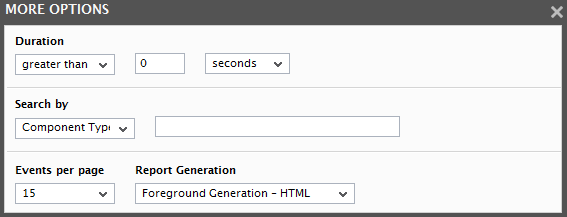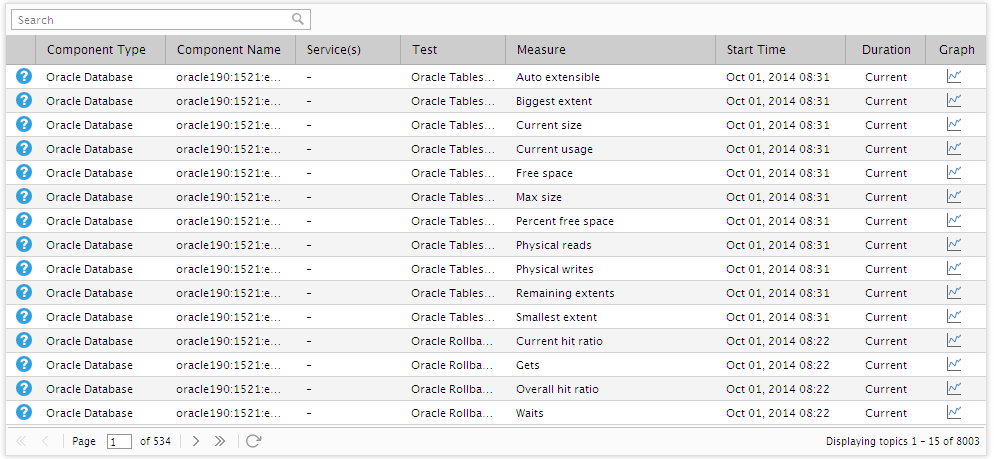History of Unknowns Report
Besides alarms, eG Reporter also enables users to historically analyze those tests, measures and components that were in an unknown state during a given timeline in the past. A test can switch to an unknown state when the eG Enterprise system is unable to determine the state of one/more metrics that test reports - this could be because of any of the following reasons:
- The test could have been wrongly configured;
- The eG agent executing the test could have suddenly stopped;
- The eG agent may have been unable to pull out metrics from the server;
- The eG agent executing the test may not be able to transmit the metrics collected by that test to the eG manager, owing to say, poor network connectivity;
Performing effective reactive analysis on the unknown measures, will enable administrators to understand which tests and measures often switched to the 'indeterminate' state and why, and which components and business services were affected by this switch. For this analysis, the eG Reporter allows the generation of the History of Unknowns report.
To generate this report, do the following:
- From the eG Reporter interface, select the History of Unknowns option from the Operational Reports node of the REPORTS BY FUNCTION tree.
-
Figure 1 will then appear.

-
From the Analyze by list, pick a criterion for filtering the Component Type list. By default, the Components option will be chosen from the Analyze by list - this is why, all the managed component types in the environment will be made available for selection in the Component Type list. In large environments characterized by numerous components of heterogeneous types, this Component Type list will be very long, making selection difficult! To avoid this, you can pick any of the following filter criteria instead from the Analyze by list:
- Service: Select this option if the components of interest to you are engaged in the delivery of a particular business service. If this option is chosen, then a Service drop-down will appear, from which you can select a specific service. The Component Type list will then be populated with only those component types that are associated with the chosen service.
- Segment: Select this option if the components of interest to you are part of a segment topology. If this option is chosen, then a Segment drop-down will appear, from which you can select a specific segment. The Component Type list will then be populated with only those types of the component that belong to the chosen segment.
- Zone: Select this option if the components of interest to you have been added to a specific zone. If this option is chosen, then a Zone drop-down will appear, from which you can select a specific zone. The Component Type list will then be populated with only those components that are part of the chosen zone. If the selected Zone contains sub-zone, you can additionally indicate whether/not the component types that are included in the sub-zones should also appear in the Component Type list. To include the sub-zone components as well, set the Include Subzones flag to Yes; to disregard the components in sub-zones, set this flag to No.
- Pick a type from the Component Type list.
- From the Components list, select one/more components for which the report is to be generated. If the Components list consists of too many components, then viewing all the components and selecting the ones you need for report generation could require endless scrolling. To avoid this, you can click the
 icon next to the Components list. The COMPONENTS pop up window will then appear using which you can view almost all the components in a single interface and select the ones for which the report is to be generated.
icon next to the Components list. The COMPONENTS pop up window will then appear using which you can view almost all the components in a single interface and select the ones for which the report is to be generated. -
Then, specify the Timeline for the report. You can either provide a fixed time line such as 1 hour, 2 days, etc., or select the Any option from the list to provide a From and To date/time for report generation.
Note:
For every user registered with the eG Enterprise system, the administrator can indicate the maximum timeline for which that user can generate a report. Once the maximum timeline is set for a user, then, whenever that user logs into eG Reporter and attempts to generate a report, the Timeline list box in the report page will display options according to the maximum timeline setting of that user. For instance, if a user can generate a report for a maximum period of 3 days only, then 3 days will be the highest option displayed in the Timeline list - i.e., 3 days will be the last option in the fixed Timeline list. Similarly, if the user chooses the Any option from the Timeline list and proceeds to provide a start date and end date for report generation using the From and To specifications, eG Enterprise will first check if the user's Timeline specification conforms to his/her maximum timeline setting. If not, report generation will fail. For instance, for a user who is allowed to generate reports spanning over a maximum period of 3 days only, the difference between the From and To dates should never be over 3 days. If it is, then, upon clicking the Run Report button a message box will appear, prompting the user to change the From and To specification.
-
In addition to the settings discussed above, this report comes with a set of default specifications. These settings are hidden by default. If you do not want to disturb these default settings, then you can proceed to generate the report by clicking the Run Report button soon after you select one/more components from the Components list for report generation. However, if you want to view and then alter these settings (if required), click on the
 icon. The default settings will then appear in the MORE OPTIONS drop down window. The steps below discuss each of these settings and how they can be customized.
icon. The default settings will then appear in the MORE OPTIONS drop down window. The steps below discuss each of these settings and how they can be customized.
Figure 2 : The default settings of the History of Unknowns report
- If you wish to view the history of unknowns assigned to a chosen user in your environment, then select the user from the User(s) list. By default, All option will be chosen from this list indicating that the tests and measures in the Unknown state pertaining to all the users will be listed by default. The User(s) list will appear only when you set the Show_Users flag to true under the [ALARM_HISTORY] section in the eg_ui.ini file that is available in the <eG_INSTALL_DIR\manager\config\default folder. By default, the Show_Users flag is set to false.
- Next, to know which tests and measures reported for which component were in an unknown state for a time period that is in excess of a specified duration, select the greater than option from the Duration list, enter a value in the adjacent text box, and then select a unit of time from the list box alongside. For example, to view the tests and measures that have remained in the unknown state for over 1 hour, select the greater than option, enter 1 in the text box alongside, and select hours from the list box adjacent to it.
- Similarly, you can view the tests and measures that were in an unknown state for a time period lesser than a specified duration. To achieve this, select the lesser than option from the Duration list, specify a value in the adjacent text box, and select a unit of time from the list box.
- To search for a specific Component Type, Component, Service or test that was in an UNKNOWN state , you can use the Search by drop down list and provide the name of the Component Type, Component, service or test of your choice in the text box adjacent to the list. In addition, if you wish to filter out the measures that were in Unknown state, you can do so by selecting the Measure option from the Search by list and provide the name of the measure in the text box adjacent to it.
- In addition, you can configure the number of unknown event records to be displayed per page of the unknown history. By default, 15 records are displayed per page. To display more records, select an appropriate value from the Events per page list.
-
In large environments, reports generated using months of data can take a long time to complete. Administrators now have the option of generating reports on-line or in the background. When a report is scheduled for background generation, administrators can proceed with their other monitoring, diagnosis, and reporting tasks, while the eG manager is processing the report. This saves the administrator valuable time. To schedule background processing of a report, you can either select the Background Save - PDF option or the Background Save - CSV option from the Report Generation list. In this case, a Report Name text box will appear, where you would have to provide the name with which the report is to be saved in the background. To process reports in the foreground, select the Foreground Generation - HTML option from this list.
Note:
- The Report Generation list will appear only if the EnableBackgroundReport flag in the [BACKGROUND_PROCESS] section of the eg_report.ini file (in the [EG_INSTALL_DIR]\manager\config directory) is set to Yes.
- The default selection in the Report Generation list will change according to the Timeline specified for the report. If the Timeline set is greater than or equal to the number of days specified against the MinDurationForReport parameter in the [BACKGROUND_PROCESS] section of the eg_report.ini file, then the default selection in the Report Generation list will be Background Save - PDF. On the other hand, if the Timeline set for the report is lesser than the value of the MinDurationForReport parameter, then the default selection in the Report Generation list will be Foreground. This is because, the MinDurationForReport setting governs when reports are to be processed in the background. By default, this parameter is set to 2 weeks - this indicates that by default, reports with a timeline of 2 weeks and above will be processed in the background.
-
Finally, click the Run Report button to generate the report. Figure 3 then appears.

- The history of UNKNOWNS report also comprises of a GRAPH icon, which when clicked, allows you to view the graph of the corresponding measure for the last one hour.
-
You can even search for unknown information based on any of the following Search options from the report:
- a particular Component Name;
- a Component Type;
- a Service;
- a Test;
- a Measure;
Pick any of the aforesaid options and enter the component name/type/service/test/measure to search for in the text box provided alongside.
- The NEXT, PREVIOUS, last and first buttons, and the Page text box are provided to enable you to easily browse the Unknown information that runs across pages.
